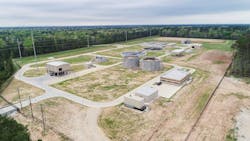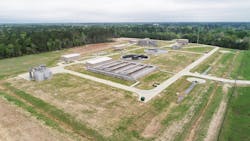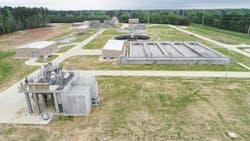Conroe Central Wastewater Treatment Plant | 2023 WWD Top Projects
- Location: Conroe, Texas
- Cost: $59.8 million
- Size: 4,167 GPM
- Owner: Norman McGuire
- Designer: Bill Schlafer, LAN
- Contractor: LEM Construction
- Manufacturers: Hydro International, Sanitaire, Five Star, SuezKat
The Conroe Central Wastewater Treat-ment Plant is the largest capital project in the city’s history at $60 million for a 6 million gallons per day (MGD) plant.
In Texas, when a plant exceeds 75% of its rated capacity, the Texas Commission on Environmental Quality requires the design of additional capacity be in the works. This was the case for Conroe, Texas, where population growth created the need for more capacity, and rising energy costs became a core consideration of plant design along with other needs, said Bill Schlafer, Lockwood, Andrews & Newnam (LAN) senior project manager.
“The $60 million Conroe Central Wastewater Treatment Plant was initiated to address this issue, catering to rising demands from residential, commercial and industrial sectors,” Schlafer said. “Beyond current needs, its design is future-focused, ensuring scalability and adaptability for coming decades, reflecting Conroe’s proactive approach to infrastructure in light of anticipated growth.”
From influent lift stations and force mains to sludge thickening, SCADA and a new administration building, the wastewater treatment plant was designed to incorporate carbon diversion, anaerobic digestion and gas-to-energy production in the future roadmap.
These future considerations are intended to meet client, community and climate benefits. Original designs were for a two-stage carbon diversion process, but that design was altered to a hybrid design to reduce project costs. That change required the use of second stage aeration basins with larger blowers because the loading increased without the carbon diversion, meaning digestion was also changed from anaerobic to aerobic. However, the system is able to adapt to an anaerobic design in the future should conditions change, meaning initial construction would not be abandoned.
The reason for the shift to the hybrid design occurred at 75% of the design stage when environmental impacts and concerns required a change in project location. Ultimately, the city and designer discovered a site acceptable to TCEQ that would also accommodate the ultimate wastewater discharge while ensuring accessibility for trunk sanitary sewers to divert flow to the new plant.
“The site layout/design needed to be revised for the new property and a new discharge location,” Schlafer said. “All of these tasks had to be accomplished in a timely manner to keep the project within budget as delays in construction activities for any extended period of time typically lead to increased costs.”
Schlafer said LAN engaged the local contractors when the site location changed to streamline the process, optimize efficiency and minimize or eliminate the potential for extra costs. In the end, he said the project saved more than $4 million with value engineering principles in the design and bid phases.
“This approach ensured the project remained aligned with the city’s budget and construction was completed with only 0.3% in non-owner directed change orders, demonstrating our team’s commitment to budgetary discipline even amidst unforeseen challenges,” he added.
Watch the Conroe Central WWTP Top Projects video:
About the Author
Bob Crossen
Bob Crossen is the vice president of content strategy for the Water and Energy Groups of Endeavor Business Media, a division of EndeavorB2B. EB2B publishes WaterWorld, Wastewater Digest and Stormwater Solutions in its water portfolio and publishes Oil & Gas Journal, Offshore Magazine, T&D World, EnergyTech and Microgrid Knowledge in its energy portfolio. Crossen graduated from Illinois State University in Dec. 2011 with a Bachelor of Arts in German and a Bachelor of Arts in Journalism. He worked for Campbell Publications, a weekly newspaper company in rural Illinois outside St. Louis for four years as a reporter and regional editor.



